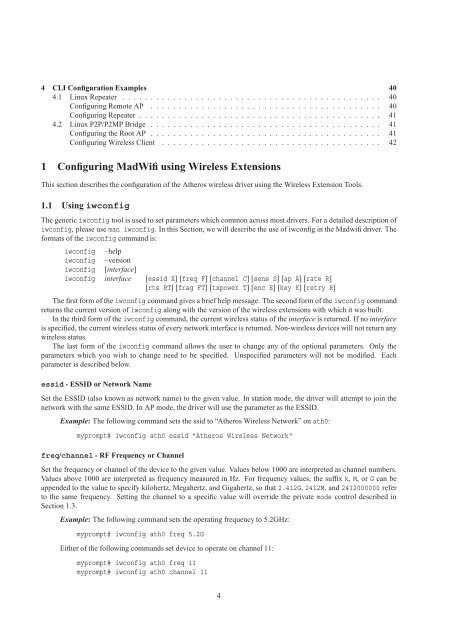Madwifi/Atheros Wireless Linux Driver Users Guide - MadWifi project
Madwifi/Atheros Wireless Linux Driver Users Guide - MadWifi project
Madwifi/Atheros Wireless Linux Driver Users Guide - MadWifi project
You also want an ePaper? Increase the reach of your titles
YUMPU automatically turns print PDFs into web optimized ePapers that Google loves.
4 CLI Configuration Examples 40<br />
4.1 <strong>Linux</strong> Repeater . . . . . . . . . . . . . . . . . . . . . . . . . . . . . . . . . . . . . . . . . . . . . . 40<br />
Configuring Remote AP . . . . . . . . . . . . . . . . . . . . . . . . . . . . . . . . . . . . . . . . . 40<br />
Configuring Repeater . . . . . . . . . . . . . . . . . . . . . . . . . . . . . . . . . . . . . . . . . . . 41<br />
4.2 <strong>Linux</strong> P2P/P2MP Bridge . . . . . . . . . . . . . . . . . . . . . . . . . . . . . . . . . . . . . . . . . 41<br />
Configuring the Root AP . . . . . . . . . . . . . . . . . . . . . . . . . . . . . . . . . . . . . . . . . 41<br />
Configuring <strong>Wireless</strong> Client . . . . . . . . . . . . . . . . . . . . . . . . . . . . . . . . . . . . . . . 42<br />
1 Configuring <strong>MadWifi</strong> using <strong>Wireless</strong> Extensions<br />
This section describes the configuration of the <strong>Atheros</strong> wireless driver using the <strong>Wireless</strong> Extension Tools.<br />
1.1 Using iwconfig<br />
The generic iwconfig tool is used to set parameters which common across most drivers. For a detailed description of<br />
iwconfig, please use man iwconfig. In this Section, we will describe the use of iwconfig in the <strong>Madwifi</strong> driver. The<br />
formats of the iwconfig command is:<br />
iwconfig –help<br />
iwconfig –version<br />
iwconfig [interface]<br />
iwconfig interface [essid X] [freq F] [channel C] [sens S] [ap A] [rate R]<br />
[rts RT] [frag FT] [txpower T] [enc E] [key K] [retry R]<br />
The first form of the iwconfig command gives a brief help message. The second form of the iwconfig command<br />
returns the current version of iwconfig along with the version of the wireless extensions with which it was built.<br />
In the third form of the iwconfig command, the current wireless status of the interface is returned. If no interface<br />
is specified, the current wireless status of every network interface is returned. Non-wireless devices will not return any<br />
wireless status.<br />
The last form of the iwconfig command allows the user to change any of the optional parameters. Only the<br />
parameters which you wish to change need to be specified. Unspecified parameters will not be modified. Each<br />
parameter is described below.<br />
essid - ESSID or Network Name<br />
Set the ESSID (also known as network name) to the given value. In station mode, the driver will attempt to join the<br />
network with the same ESSID. In AP mode, the driver will use the parameter as the ESSID.<br />
Example: The following command sets the ssid to “<strong>Atheros</strong> <strong>Wireless</strong> Network” on ath0:<br />
myprompt# iwconfig ath0 essid "<strong>Atheros</strong> <strong>Wireless</strong> Network"<br />
freq/channel - RF Frequency or Channel<br />
Set the frequency or channel of the device to the given value. Values below 1000 are interpreted as channel numbers.<br />
Values above 1000 are interpreted as frequency measured in Hz. For frequency values, the suffix k, M, or G can be<br />
appended to the value to specify kilohertz, Megahertz, and Gigahertz, so that 2.412G, 2412M, and 2412000000 refer<br />
to the same frequency. Setting the channel to a specific value will override the private mode control described in<br />
Section 1.3.<br />
Example: The following command sets the operating frequency to 5.2GHz:<br />
myprompt# iwconfig ath0 freq 5.2G<br />
Either of the following commands set device to operate on channel 11:<br />
myprompt# iwconfig ath0 freq 11<br />
myprompt# iwconfig ath0 channel 11<br />
4


